Aapam
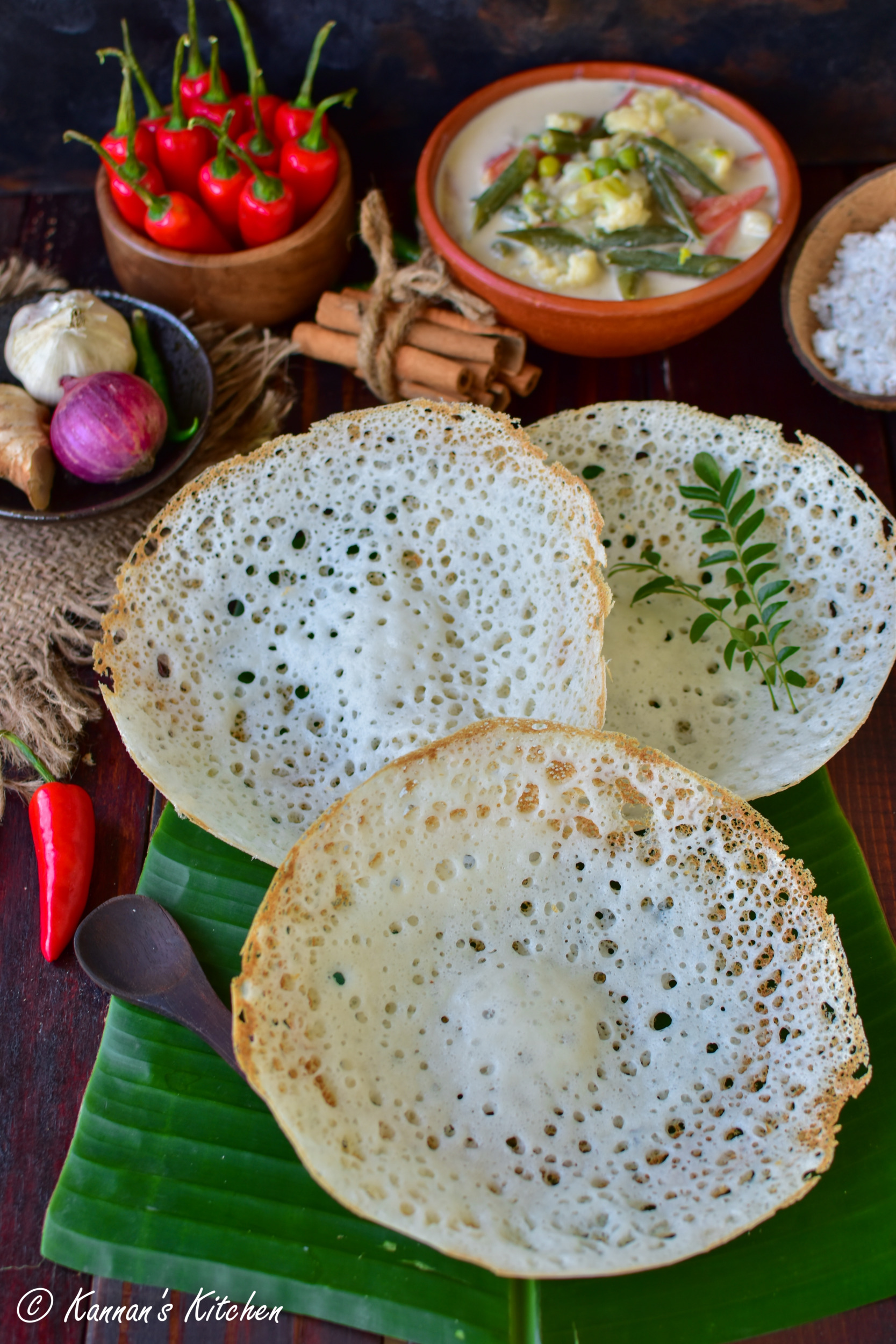
Aapam is a South-Indian style pancake made using fermented rice batter. This is an extremely popular breakfast dish which has it’s roots from the state of Kerala. It is also equally popular in Tamil Nadu.
Aapam is wonderfully light and is characterized by the numerous pores resulting out of good fermentation. It has a crisp outer layer and a fluffy and spongy centre. Aapam is traditionally made in a concave shaped pan which is called as an Aapam pan. This pan helps give the aapam it’s difference in texture as when the batter is swirled, the extra batter settles in the centre making it spongy and the thin coating on the sides give a crisp texture.
At a glance, Aapam seems to be a sibling of the Dosa and it technically belongs to this family, however there are some differences even though Dosa is also made using fermented rice batter! Firstly, dosa typically is made a combination of rice and lentils (usually urad dal), whereas Aapam does not contain any lentils in it’s recipe and just rice is used. Similarly, the agents used for fermentation for Aapam is different than a dosa. Since Aapam needs to be light and fluffy from centre, it requires extra fermentation and there are numerous ways to achieve this. This is where the recipe of Aapam varies from family to family. Some use yeast, some use cooked rice. or a small amount of cooked batter or even toddy.
The key to a good Aapam is fermentation. I cannot stress more how important this process is for this recipe! In this recipe, I shall be using yeast and a small amount of cooked rice for the fermentation and it works perfectly well. You could also use just either of them and could yield similar results, but I prefer using a combination of the two, as sometimes just using yeast demands some extra amount for proper fermentation and yields a distinct smell and flavour in the Aapam which some don’t like.
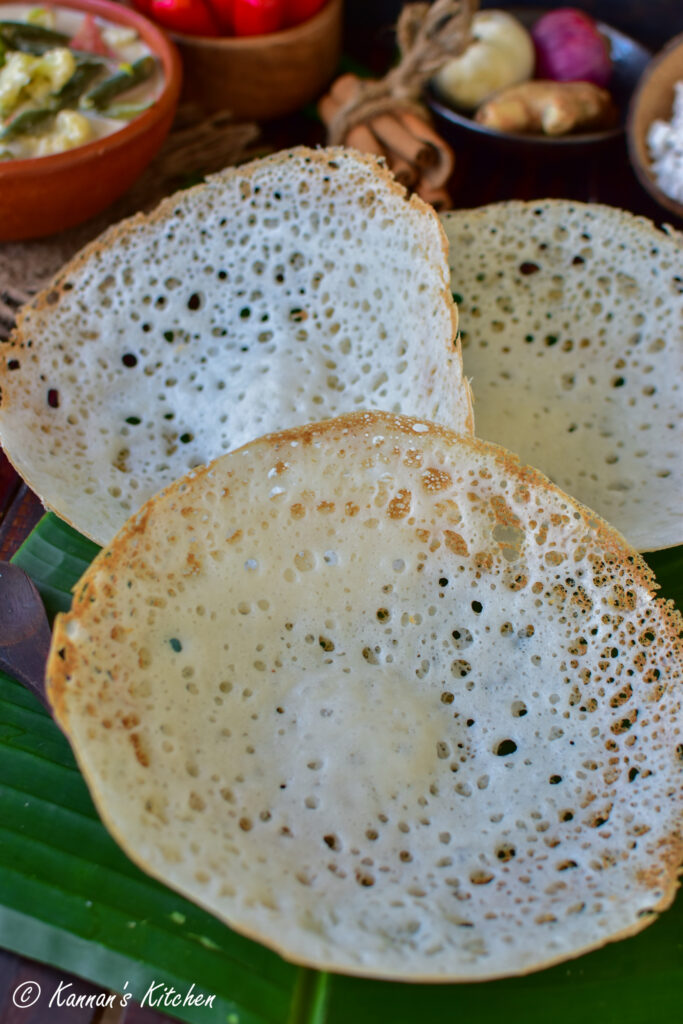
Aapam consumes little to no oil which makes it a very healthy option for breakfast. I use a non stick Aapam pan for making Aapam and I do not use a single drop of oil for cooking and trust me it works perfect! If you are using a well seasoned cast iron pan, you might just require few drops of oil for making each Aapam. If you do not have an Aapam pan, you could also make Aapam in a small kadai which is not deep and slightly shallow. However I highly recommend investing in one for getting the perfect Aapams!
Now let us look at the ingredients used in the recipe and the significance of each.
Dosa Rice:
In my recipe, I use dosa rice (you could use any raw rice of your choice) and this is the main base of the recipe. Dosa rice gives the crisp outward texture for the Aapams.
Flattened Rice or Poha:
Poha adds to the softness of the Aapam and is very important for a fluffy centre. Just using raw rice would not yield a soft centre. The ratio of poha or aval is half of the raw rice.
Grated Coconut:
Grated coconut is also a key ingredient in the recipe of Aapam and gives it a subtle yet distinct flavour. For those who have not been using this ingredient in the recipe, give it a try and never omit this ingredient in Aapam.
Cooked Rice:
I add a small amount of cooked rice while grinding the batter of Aapam, as this yields in the fermentation of the batter and also makes it soft. I use this in combination with yeast to reduce the amount of yeast required for fermentation.
Yeast:
Yeast aids in the fermentation of the batter and is quite important to get the beautiful pores in the Aapam. I use Active dry yeast which needs to be activated by mixing it in warm water along with some sugar, before it could be added to the batter. You could also use instant yeast for this recipe, however I have seen Active dry yeast works best for me!
Coconut Water:
I also use a small amount of coconut water in the Aapam for that distinct fermentation flavour.
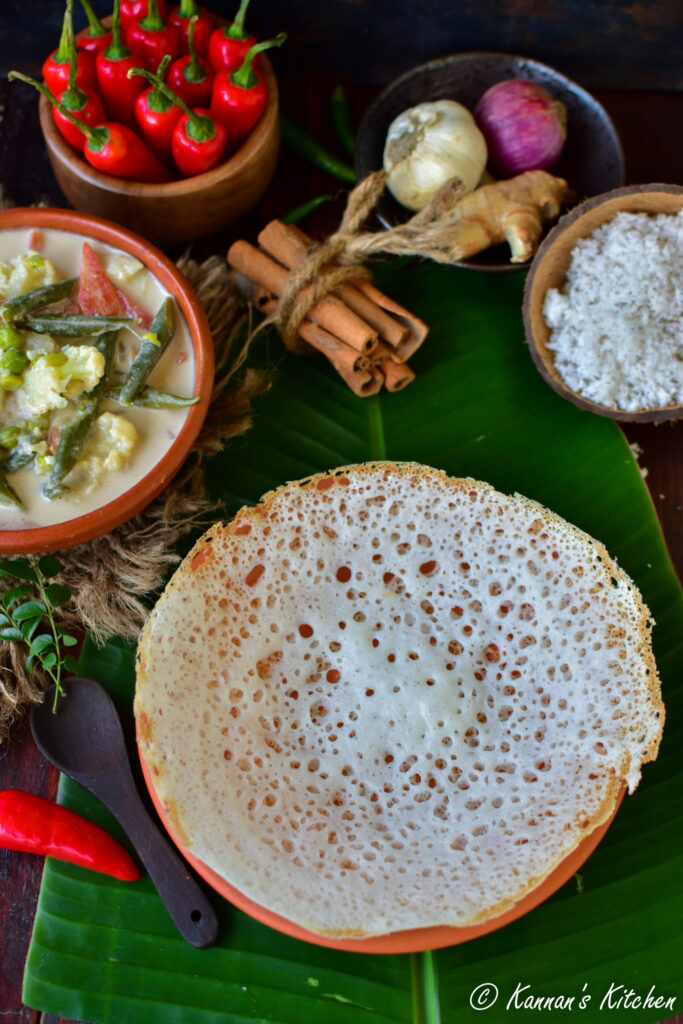
Serving Suggestion
Aapam is traditionally served as a breakfast dish, however it can be enjoyed as a meal anytime of the day. There are numerous side dish combinations for serving Aapam and this varies from region to region.
The first and my personal preference for Aapam is a Vegetable stew made using coconut milk. The vegetable stew is very subtly flavoured, yet it has a fabulous taste and richness coming from the coconut milk. The veggies used in this stew are typically carrots, beans, potatoes, cauliflower and peas, however feel free to use any other veggie of your choice.
Another classic combination for Aapam is Kadala curry which is especially popular in Kerala. The Kadala curry is made using the dark brown chickpeas or channa in a roasted onion and coconut based gravy which is very distinct to Kerala.
Aapam is also served with just sweetend coconut milk and this combination is popular in southern Tamil Nadu.
Lastly, you could also serve Aapam with any chutney of your choice (say coconut or onion-tomato etc.). Though this is not the conventional choice, but pairs well with Aapam.

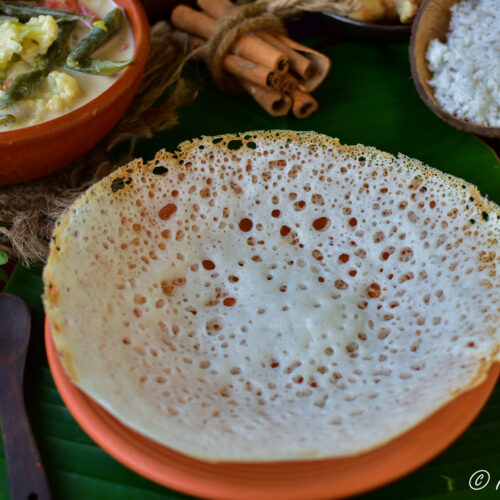
Aapam
Equipment
- 1 Aapam Pan
Ingredients
- 2½ Cups Dosa Rice
- 1¼ Cup Poha or Flattened Rice (Aval)
- ½ Cup Cooked Rice
- ½ Heaped Cup Grated Coconut
- 1 tsp Active Dry Yeast
- 3 tbsp Coconut Water
- 1 tsp Sugar
- Salt to taste
Instructions
- Wash the dosa rice and soak in water for around 4 to 5 hours
- Wash the poha or flattened rice and soak in water for around 2 hours
- Drain the water from dosa rice and poha. In a mixer grinder, add the soaked rice in portions and blend. After the rice is fairly smooth, add portion of the soaked poha and grind to a fine paste. Repeat the process for the remaining batch.
- For the final batch, add the grated coconut as well and the cooked rice and blend smooth.
- Take around 1/4 cup of lukewarm water and add sugar. Now add the active dry yeast and gently mix. Let this mixture rest for 5 to 10 minutes till the yeast is activated. The sign of activation is the mixture becoming frothy and fluffy. If it does not become fluffy, discard the yeast and use a different lot as it is not activated.
- Now mix the yeast mixture and coconut water to the ground batter and add half the amount of salt and mix well. Let this batter rest overnight or for 8 hours in a warm place for proper fermentation. Make sure to use a large vessel, so that there is ample space for the batter to rise, else the batter would overflow out of the vessel.
- Once the batter is fermented, you would see that the batter would have become slightly thinner and aerated. This is a sign of good fermentation.
- Now add the remaining salt for the batter and mix gently. Add some more water if required. The consistency of batter should be very flowy and thinner than the dosa batter. However do not make it too watery either.
- Now heat the Aapam pan and pour a big ladle of the batter in the pan and by holding the handles on both sides, swirl the batter in 360 degree motion to spread the batter well in the pan. Finally the residual batter would settle to the centre which would turn fluffy on cooking.
- Add a tiny amount of oil if you are using a cast iron pan. However if you are using non-stick this recipe does not require any oil for cooking. Cover the Aapam pan with a lid and cook on a medium flame for 2-3 minutes.
- Open the lid and check if the corners have turned slightly brown and crisp and if you touch the centre it must not stick to hand. Remove carefully from the pan by releasing one side and then pulling the aapam using hand
- Serve the Aapam hot with a side dish of your choice.
Notes
- You can use any raw rice of your choice if you do not have dosa rice. Do not use parboiled rice though.
- The Aapam batter must be ground very smooth and should not be grainy.
- The amount of yeast required for full fermentation might also depend on some other conditions like ambient temperature, weather etc. 1 teaspoon of active dry yeast works well for me, however if there is not enough fermentation, you could use up to 1.25 teaspoon of yeast.
- If you are using instant yeast, then you could skip the step of activating it my mixing in warm water with sugar and directly add it to the batter. However you could follow the same process for instant yeast too.
- The Aapam batter becomes slightly runny on fermentation, so make sure that the batter is not too watery before it is fermented.
- While making the Aapam, make sure that the batter is flowy enough and consistency should be thinner than dosa batter.
- If the batter is too thick, it would not spread well and the pores would not appear properly on the aapam.
- At the same time, if batter is too runny it would not coat the pan well, the outer edges would be too thin and all the batter would settle to the centre yielding a very thick Aapam.
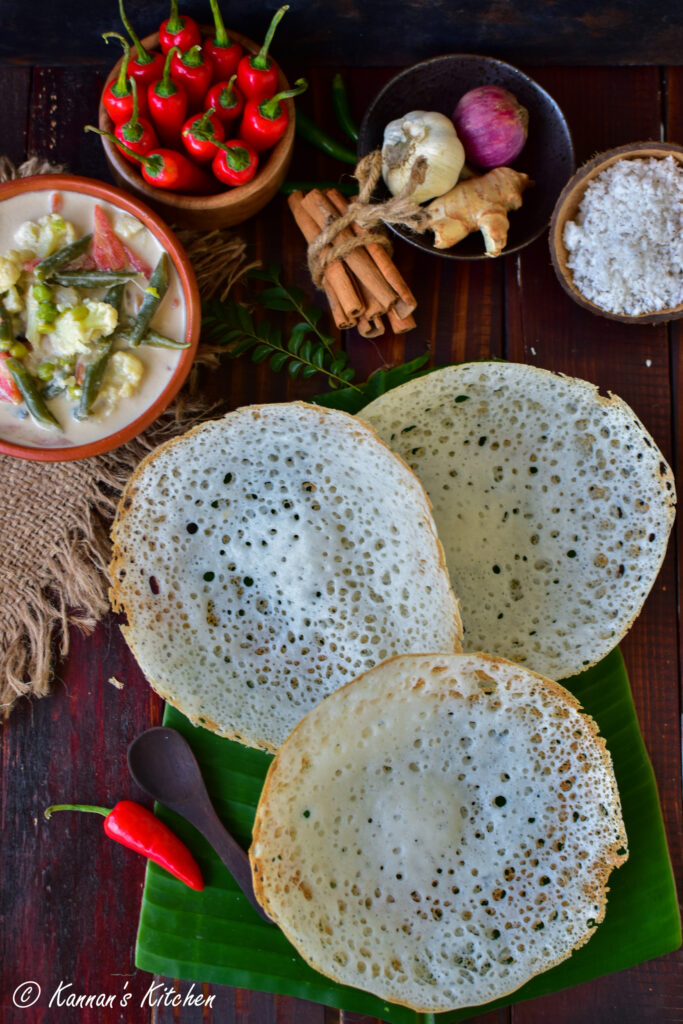


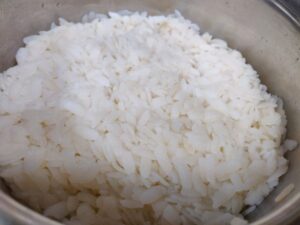
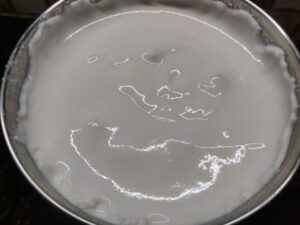
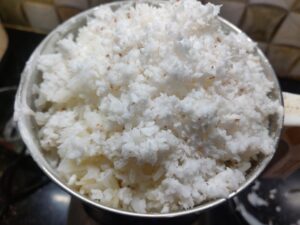
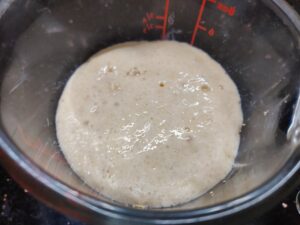
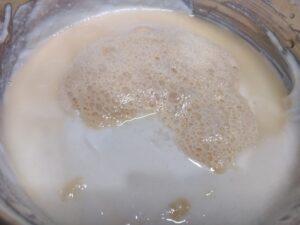
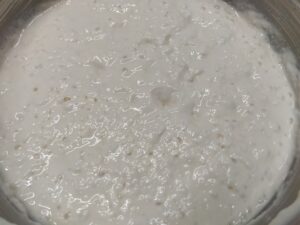

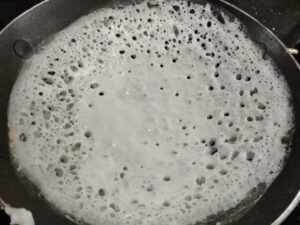
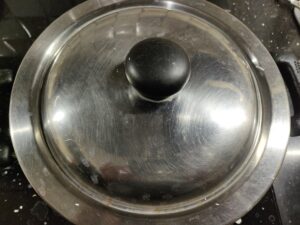
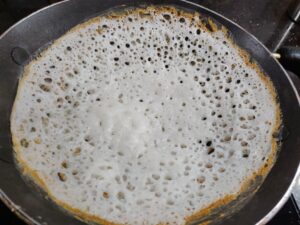
1 thought on “Aapam”